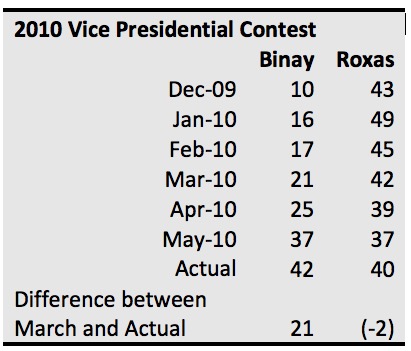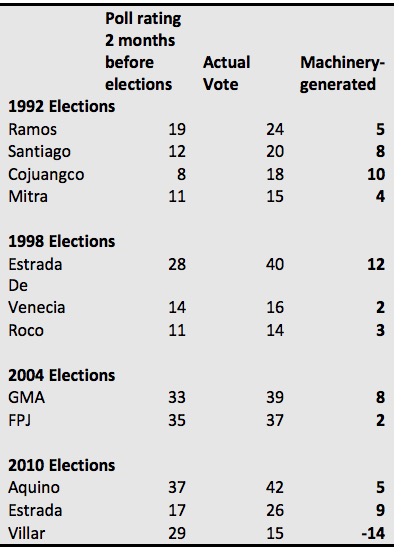Polls, therefore, mostly tell you which candidate is the most popular at the moment. But especially in a poor country like ours, popularity doesn’t all translate to votes. Call it the electoral or command machine, a candidate’s network, his organization’s capability to buy votes, voters’ memory due to a candidate’s actual visit to a town, or as the Americans term it, the ground campaign—this X factor is not captured by polls until perhaps a few weeks before the elections.
This was very dramatically demonstrated in the 2010 vice presidential contest. Roxas then, hands down, came to be the most popular candidate at that time, miles ahead of Jejomar Binay, Loren Legarda and Bayani Fernando. As election day neared though, Roxas’ voter-preference peak of 49 percent rating began slipping steadily to 39 percent by April.
That of Binay rose steadily to 21 in March, and leapt to 25 percent in April and climbed further to 37 percent in May.
Binay during these months did not launch any special image-boosting program to create a breakthrough in his popularity, but neither did Roxas commit any monumental blunder to damage his image.
The reason for Binay’s rise in voter-preference ratings was that, in April and May, he rolled out his machine, his network. This was built up over the years by such moves as setting up Makati’s sister-city relations (and, of course, they came along with donations such as ambulances) with the majority of cities and municipalities, his Boy Scout network, and his links with his UP law fraternity Alpha Phi Omega (APO), which he had strengthened over the years. APO has been one of the most elite frats in UP, with its members occupying the commanding posts in mainstream business and politics.
Binay’s machine delivered 21 percentage points more, adding to his voter-preference rating of 21 percent in March, so that he got 42 percent of the actual votes cast in the end.
 In contrast, Roxas had never developed such ground network, and is not a member of any similar fraternity, nor a leader of a nationwide organization as the Boy Scouts. His world is that of the traditional elite and the country’s big business, who really don’t care about elections.
In contrast, Roxas had never developed such ground network, and is not a member of any similar fraternity, nor a leader of a nationwide organization as the Boy Scouts. His world is that of the traditional elite and the country’s big business, who really don’t care about elections.
With his cacique mentality, Roxas thought that his popularity, together with the Liberal Pary’s machinery and huge finances, were enough to win the vice presidential race. His final votes stood at 40 percent, one of just two cases (the other being Villar’s in 2010) when a presidential or vice presidential final votes fell from the candidate’s ratings two months before the elections.
This “machine” is a complex one, more of a living organism that a candidate has to personally nurture for several years.
For instance, even if a candidate has billions of pesos of campaign funds to spend (as Roxas, Manuel Villar and Ramon Mitra had done in different elections), someone must still do the work of approaching the mayors or the governors to deliver the bribe money to the local political leaders, as well as the task of distributing the all important sample ballots on election day. That is the function of the political machine. A candidate would have to have his trusted allies – mainly, from governors down to the mayors and their ward leaders – in place all over the archipelago – all with some loyalty to their candidate and confident that their candidate still has a chance of winning. Such a network, however, can’t be built overnight.
To believe that 100 percent of the masses choose their candidate is naive. More often, especially in the rural areas, it is the political leader in his community who tells the masa whom to vote for, and he follows that directive for various reasons, even for such irrational fear that he would be found out if he didn’t.
I visited the provinces in the 1992 elections, when the LDP’s Ramon Mitra supposedly had a formidable machinery in place. I saw for myself how two governors, supposedly pillars of Mitra’s party, the LDP, would tell the people to just keep Mitra’s sample ballots and posters in their warehouse. This was because they had already given their commitment of support to Mitra’s rival who, I was told, had already parted with some money – P500,000 each to the two governors.
How much does the political machine contribute to the actual polls? I’d compute this as the difference between the actual vote percentages and the March survey ratings, after which a candidate fully mobilizes his machine.
My estimates of these “machinery votes” for presidential contests since 1992 are shown in the following table:
In the 1992 elections, the machinery-generated votes ranged from 5 percentage points (for Ramos) to 10 percentage points for Cojuangco. The big number of votes garnered by the San Miguel owner confirms the well-known strength of his political machine, built up during Marcos’ 13 years in power, his network among coconut planters and the nationwide distribution system of the beer giant.
In the 1998 elections, the machinery votes delivered 12 percentage points to Estrada and only 3 percentage points to Jose de Venecia and Raul Roco. The latter two candidates’ machinery had collapsed by May, with their financiers closing the tap, as Estrada’s popularity seemed insurmountable.
In the 2004 elections, Gloria Macapagal-Arroyo’s machine delivered 8 percent, which was crucial in defeating the popular Fernando Poe Jr., whose network managed to generate only 5 percentage points more votes.
In the 2010 elections, Benigno Aquino 3rd’s machine delivered 5 percentage points in addition to his already high ratings, with Estrada’s 9 percentage points generated by his network not enough to overcome Aquino’s high popularity rating of 37 percent in March of that year.
So how do we rationally forecast the elections this May, factoring in the machinery votes? The presidential polls so far show the following:
2016 polls 2
Poe’s ratings peaked in June 2015 at 42 percent, before drifting down to 27 percent in March this year. Her popularity is far from the kind her adoptive father FPJ enjoyed, whose ratings never dipped below 31 percent throughout the campaign period. This, of course, is not unexpected, as she, unlike her father, is not herself a movie persona but the daughter of the popular persona of “Panday.”
She has actually flamed out, with confidential polls I have seen putting her ratings down to 12 percent, both because Filipinos must have grown tired of her as a novelty and as her renunciation of her Filipino citizenship has put serious doubt on voters’ minds about her patriotism. It is Duterte who has mainly taken away the preference votes from Poe.
Binay, meanwhile, has survived the intense and very well funded black propaganda against him undertaken by Aquino’s yellow army, with his polls stabilizing at 24 percent. Duterte’s ratings have been going up from the single-digit levels to over 20 percent because of his shocking sound bites Filipinos like. Roxas’ ratings can’t go past the 20s.
Poe and Duterte, however, don’t have a machine, and time has run out for them to build such a network at this point. They have deluded themselves into thinking that politicians expressing support for them would mean that they would actively campaign for them. The politicians who appear to be supporting them only do so in their calculation that Poe’s or Duterte’s popularity would rub off on them.
They and their political strategists, amazingly, seem to think that popularity converts into votes 100 percent. It seems to me that Poe’s strategists are the two young sons of William Gatchalian, with Estrada providing some advice through the fog of his often drunken, aging mind.
The leaders of Duterte’s camp are people who have hardly gone out of their Davao provincial world, except for strategist Lito Banayo, one of Estrada’s close advisers and operators before and after he won the presidency in 1998. The Dominguez brothers (Sonny and Paul), as well as big financial supporter Antonio Floirendo, have dabbled in political campaigns but remained basically businessmen without being known to have national political networks.
Contrast these to Binay’s camp, whose campaign is being run by Ronaldo Puno, according to a Philippine Daily Inquirer report in February. Puno’s expertise in running a campaign is unmatched by anyone in the country, having studied the country’s political landscape and built up his own network first, as one of Marcos’ liaisons in local government for 13 years and then, as DILG secretary under Estrada and Arroyo. Most significantly, Puno had run the uphill but successful presidential campaigns of Ramos in 1992 and Arroyo in 2004.
Without a national political machinery running, Poe’s and Duterte’s March ratings are not likely to change much on election day, or at best, perhaps would by only a few percentage points.
Miriam Defensor-Santiago is the classic case of a candidate zooming up the heights of popularity seemingly defying the political landscape, as Poe and Duterte appear to be doing. But even the fiery Miriam, without a machine, could generate only two percentage points of additional votes on election day, so that her April 1992 poll rating of 18 percent gave her only 20 percent actual votes in the end. That wasn’t enough to defeat the 24 percent Fidel Ramos received, with his machine generating 6 percentage more points from his April rating of 18 percent.
Roxas has the Liberal Party’s, and more importantly, the incumbent President’s machine. But the precedent here could be the largest party’s candidate in 1992 and the ruling-party’s candidate in 2010 – Ramon Mitra and Jose de Venecia, respectively – both of whose popularity (or lack of it) was in the same league as Roxas’ now.
Mitra’s machine delivered only 4 percentage points, while De Venecia received only 2 percent more votes. Both lost in that election.
Like Mitra and de Venecia, Roxas’ machine could stall because he has been landing 4th in the polls, and no presidentail candidate with such basement ratings has ever frog-leaped past two leading candidates to win. The people running his machine, the governors and mayors, as they have always done, are likely to leave a perceived loser, pocket the funds Roxas gave them, and jump to his rivals’ camps as the election nears.
My bet is that Binay’s machine could deliver 10 percentage points from his March ratings, using as a basis for this, Arroyo’s 8 percentage points machinery votes in 2004 and half of the huge 21 percentage points in votes the vice president’s machine generated in the vice presidential contest in 2010.
I’d give Roxas an optimistic 4 percentage points in machinery-delivered votes, which is what Mitra, also the No. 4 dweller in the 1992 elections, received. Poe’s and Duterte’s machines, at most, could deliver only 5 percentage points, similar to what FPJ’s machine delivered in 2004.
My forecast, therefore, using past data on machinery-generated votes since 1992, and based on the SWS’ March voter-preference surveys, is as follows:
I’m betting, however, that Binay could get as high as 40 percent, with a steep loss in Poe’s rating to 12 percentage points divided between Duterte and Binay.
The indisputable lesson of Philippine elections is this: It is not the most popular candidate according to opinion surveys, or he who has the strongest machine, who gets the highest votes, but he or she who has the most optimal mix of both popularity and political machine emerges the winner.
This email address is being protected from spambots. You need JavaScript enabled to view it.
source: http://www.manilatimes.net/only-binay-and-roxas-have-electoral-machinery/253878/











